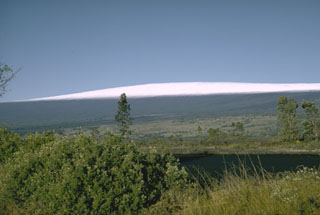Report on Mauna Loa (United States) — July 1991
Bulletin of the Global Volcanism Network, vol. 16, no. 7 (July 1991)
Managing Editor: Lindsay McClelland.
Mauna Loa (United States) Summit earthquake swarm
Please cite this report as:
Global Volcanism Program, 1991. Report on Mauna Loa (United States) (McClelland, L., ed.). Bulletin of the Global Volcanism Network, 16:7. Smithsonian Institution. https://doi.org/10.5479/si.GVP.BGVN199107-332020
Mauna Loa
United States
19.475°N, 155.608°W; summit elev. 4170 m
All times are local (unless otherwise noted)
Surface deformation measurements indicate gradual reinflation of Mauna Loa's summit since its 1984 eruption. Earthquake counts have fluctuated, but have apparently increased since late 1990.
Two bursts of intermediate-depth volcanic tremor, beginning at about 1200 on 13 July, preceded a swarm of long-period earthquakes that continued for ~14 hours. Activity peaked between 2300 on 13 July and 0100 the next morning. As the long-period events gradually declined, shallow microearthquake activity increased, and continued for about 6 hours. All of the events were too small for precise location.
The 13 July activity began ~2 hours before an earthquake swarm under the summit of Kīlauea. Seismicity at Mauna Loa has apparently returned to average background levels since mid-July.
Geological Summary. Massive Mauna Loa is a basaltic shield volcano that rises almost 9 km from the ocean floor to form the world's largest Holocene volcano. Flank eruptions typically occur from the lengthy NE and SW rift zones, and from the Moku'aweoweo summit is caldera, which is within an older and larger 6 x 8 km caldera. Two of the youngest large debris avalanches documented in Hawaii traveled nearly 100 km from Mauna Loa; the second of the Alika avalanches was emplaced about 105,000 years ago (Moore et al., 1989). Almost 90% of the surface of the volcano is covered by lavas less than 4,000 years old (Lockwood and Lipman, 1987). Beginning about 1,500 years ago, a series of voluminous overflows from a summit lava lake covered about 25% of the volcano's surface. Over the last 750 years, from shortly after the formation of Moku'aweoweo caldera until the present, an additional 25% of the volcano has been covered with lava flows, mainly from summit and NW rift zone vents.
Information Contacts: P. Okubo, HVO.

